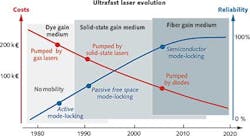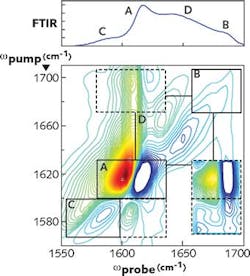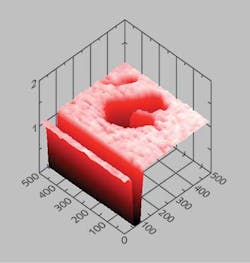Ultrafast Scientific Lasers: Ultrafast scientific lasers expand on their legacy

While ultrafast (picosecond and femtosecond) lasers are an essential subset of the lasers used today in industry and the medical arena (for example, machining glass for smartphone screens for the former, and laser eye surgery for the latter), it is the use of ultrafast lasers in research that allows such lasers to show their true colors, sometimes literally. Indeed, science is where it all began for these types of lasers, as the first ultrafast lasers were themselves research projects.
Types of ultrafast scientific lasers include oscillators and amplifiers, either of which can be constructed using bulk or fiber-based components (or both). The use of fiber can lead to smaller, more rugged ultrafast scientific lasers, although fiber also has some intrinsic problems that must be cleverly managed: the high peak powers and the resulting high intensities experienced by the fibers (especially single-mode fibers) can lead to optical damage or to nonlinear optical effects. However, the latter can in some cases be put to good use-the outstanding example here is supercontinuum light sources, which rely on fiber nonlinearities to produce high-brightness broadband light.
The ultrafast scientific laser category includes lasers that produce the shortest femtosecond pulses commercially available. Such lasers often rely on sophisticated techniques to produce high-quality pulses, such as carrier-envelope phase (CEP) stabilization, which ensures that the phase of each few-cycle pulse is correctly aligned to the pulse envelope. To create high-energy amplified femtosecond pulses that do not damage the components in the amplifier, chirped-pulse amplification (CPA) temporally stretches the seed pulse using a dispersive element before the pulse enters the amplifier; after amplification, the high-energy pulse is then temporally compressed.
The evolution of ultrafast lasers over the years can be seen in a chart provided by fiber-based ultrafast laser maker Toptica (Munich, Germany). The first ultrafast lasers, based on a dye gain medium, were expensive and unreliable, while laser types based on solid-state gain media such as titanium sapphire (Ti:sapphire) and on optical fibers have high reliability and costs appropriate for commercial lasers (see Fig. 1).
Ultrafast fiber lasers
"Toptica produces passively mode-locked fiber lasers in the picosecond and femtosecond regime based on ytterbium (Yb) and erbium (Er) gain fiber," says Wilhelm Kaenders, Toptica's president. "We have been using polarization-maintaining fiber and saturated-absorber technologies for many years and are approaching now lifetimes in excess of 30.000 h for some of our fiber solutions." The company's lasers emit at 780, 1030, 1064, or 1550 nm.
Kaenders notes that the high continuous operation times of the Toptica lasers make them reliable emitters for scientific applications such as terahertz generation, multiphoton microscopy, two-photon polymerization (which, among other uses, can be used to fabricate photonic microstructures for research), and as precision optical clocks in timing distribution. The lasers can produce pulses with durations of 40 fs up to 10 ps, and even active repetition-rate synchronization, a quality especially useful for the production of frequency combs. The many scientific uses of frequency combs include (but are not limited to) plasma-sterilization measurements, finding exoplanets, ultraprecise time-signal transfer, trace-gas detection, and absolute-distance-measurement interferometry.
Due to their compactness, ultrafast fiber lasers make excellent seed sources for Ti:sapphire amplifiers. For example, the Q-Light-PM, made by Continuum (San Jose, CA), is a small, rugged box 18.4 × 15.7 × 6.5 cm in size that contains an Er-doped fiber laser that emits linearly polarized light frequency-doubled to a 780 nm wavelength with a beam quality (m2) of 1.2 or better, producing pulses of 110 fs or less duration at a 30–40 MHz repetition rate and resulting in an average power of 10 mW or more; the box also contains the electrical controller. In addition to seeding a Ti:sapphire amplifier, the laser can be used for image processing and biomedical research.
Ti:sapphire
Relative to other laser gain materials, Ti:sapphire has an enormous gain bandwidth that spans 680 to 1100 nm or more—and, due to the Fourier relation between spectral bandwidth and pulse duration, a large bandwidth is what's needed to create ultrashort pulses. As a result, the shortest laser pulses are typically emitted by Ti:sapphire lasers.
Coherent (Santa Clara, CA) produces three types of ultrafast scientific lasers: oscillators, amplifiers, and specialty oscillators optimized for multiphoton microscopy, along with accessories to customize the output of these devices, such as tunable optical parametric oscillators and amplifiers, harmonic generators, and other frequency-shifting modalities, according to Nigel Gallaher, senior product line manager at Coherent.
Gallaher explains how the development of industrial Ti:sapphire lasers has helped ultrafast scientific lasers. "Traditionally, there has been an unspoken but widely accepted trade-off between performance and operational simplicity/reliability; if you wanted state-of-the-art performance, you would have to be willing to have a hands-on (really hands-in!) relationship with your ultrafast laser," he says. "But in the past two or three years, this has really changed. Specifically, we are finally seeing a confluence between extreme performance and industrial-grade simplicity and reliability, which Coherent has termed an industrial revolution in ultrafast science. A key aspect of this industrial revolution has been the implementation of rigorous highly accelerated life testing and highly accelerated stress screening (HALT/HASS) development through final testing protocols, long used in other industries."
As an example, Gallaher notes that a standard product, the Vitara UBB ultrafast oscillator, has a pulsewidth of less than 8 fs—leading-edge performance that comes in a hands-off package that shows many thousands of hours of continuous operation with no user intervention.
The company's Astrella Ti:sapphire amplifier is another example, says Joseph Henrich, product line manager at Coherent. "This is the latest rendition of our on-box amplifier product concept, where everything to produce highly amplified pulses at kilohertz repetition rates is contained in a single package. This includes a Vitara seed oscillator, a stretcher-compressor, our newest amplifier pump laser, and the regenerative amplifier itself. The Astrella is particularly interesting because it's the first of our one-box amplifiers designed and tested from the ground up using the rigorous HALT/HASS protocols just mentioned." The amplifier's CPA stretcher-compressor is contained in a sealed box, with no requirement for user intervention.
The amplifier delivers 6 mJ/pulse at an m2 of less than 1.25, with a choice of <35 or 100 fs pulse widths. The 35 fs pulsewidth translates into a peak power of about 170 GW-a power achieved without the need for thermoelectric cooling of the Ti:sapphire gain crystal. Typical applications are various types of spectroscopy, including vibrational, electronic, terahertz, and even x-ray studies of core electrons via high-harmonic generation, a technique that results in attosecond light pulses.The Astrella amplifier is used, for example, in 2D infrared (IR) spectroscopy. "Conventional infrared absorption spectra are usually obtained from a Fourier-transform infrared (FTIR) instrument," says Henrich. "Each peak corresponds to a different molecular vibration, but there is no information in the spectra that describes any relationships between the vibrations. 2D IR reveals these relationships using two independent wavelengths (pump and probe) and graphing the data with the two wavelengths on orthogonal axes. If a 2D IR spectrum is recorded of a mixture, pairs of peaks from the same species will also produce off-diagonal 'cross peaks.'" Heinrich adds that 2D IR is proving to be a very useful tool in life sciences, with a unique ability to study linkages and interactions between biomolecules; for example, protein enzyme binding and protein folding and unfolding (see Fig. 2).CEP stabilization
Femtolasers (Vienna, Austria) has made CEP stabilization a key characteristic of its ultrafast oscillators and amplifiers. The company says that it has pioneered third-generation CEP technology, which allows CEP to be locked over a full working day as opposed to the conventional first-generation CEP technology, which only extends CEP locking to a tens-of-minutes length of time. The company says that, using a so-called "direct feed-forward" approach, it is working toward the fourth generation, which will permit CEP to be locked over an unlimited period of time. Attoscience researchers and other experimenters with high-harmonic-generation will benefit.
Spectra-Physics (Santa Clara, CA) produces a full line of ultrafast lasers, including oscillators, amplifiers, and single-wavelength lasers. The company's InSight DS+ system, which is intended for scientific applications such as in vivo multiphoton microscopy, has a very large 680 to 1300 nm gap-free tuning range; the expanded longer-wavelength end of the range allows the deepest in vivo imaging. A dispersion pre-compensator ensures sub-100-fs pulses, which are then delivered through a microscope to the sample under examination.
The laser system, which is designed and built to industrial standards, can also be had with a dual-synchronized beam output for simultaneous imaging of different types of fluorophores at the same time, second- and third-harmonic-generation imaging, and two synchronized output beams enable easy simultaneous imaging of various fluorophores (for instance, GFP/YFP and mCherry), SHG/THG imaging, and advanced imaging techniques such as coherent anti-Stokes Raman spectroscopy (CARS) and stimulated Raman scattering (SRS).
The company's single-box Mai Tai DeepSee ultrafast Ti:sapphire laser, which is also useful for in vivo fluorescence imaging, is a "hands-free" laser that produces 2.4 W of average power, has a 690 to 1040 nm tuning range, and uses an ultrastable regenerative mode-locking technique. The laser is also used in optical coherence tomography (OCT) and nonlinear spectroscopy.
Time-Bandwidth Products (Zurich, Switzerland), a spinoff of the Ultrafast Laser Physics group at the Swiss Federal Institute of Technology (ETH; also in Zurich) and which is now owned by JDSU (Milpitas, CA), produces diode-pumped Ti:sapphire and other solid-state ultrafast lasers that are passively mode-locked using the semiconductor saturable-absorber mirror (SESAM) technique, which, depending on the setup, can produce pulse durations in the femtosecond or picosecond range.
The company's Tiger Ti:sapphire laser produces 150 fs pulses at energies greater than 25 nJ at rates from single-shot to 4.1 MHz. The beam has an m2 of 1.1. Scientific applications include pump-probe experiments, multiphoton microscopy, nonlinear optics experiments, and time-resolved spectroscopy.
A variety of ultrafast options
But a solid-state scientific ultrafast laser does not necessarily have to be Ti:sapphire. For example, Time-Bandwidth Products also makes a neodymium glass (Nd:glass) laser that emits transform-limited sub-200 fs pulses in the 1058 nm region (tunable from 1053 to 1064 nm) at an average power of 400 mW and a user-defined, fixed pulse-repetition rate between 70 and 150 MHz that is useful for some of the same purposes as a Ti:sapphire scientific laser. In addition, the company produces a Yb-based ultrafast laser that delivers sub-200-fs pulses in the 1030 to 1040 nm region, suitable for bioimaging.
As for non-Ti:sapphire ultrafast lasers, Gallaher of Coherent notes, "Another interesting trend in the industry is the coming of age—finally—of Yb-based lasers that provide the first alternative to Ti:sapphire. An example of this is our Chameleon Discovery laser that provides much wider tunability of 680 nm to 1300 nm than titanium sapphire lasers as well as a secondary output at a fixed 1040 nm, making this an ideal solution for optogenetics microscopy experiments that often need two separate ultrafast wavelengths."
KMLabs (Kapteyn-Murnane Laboratories; Boulder, CO) is also expanding its technology to include bulk Yb-based ultrafast lasers, although what the company is traditionally known for is its Ti:sapphire lasers, many of them aimed at science. For example, its Wyvern regenerative Ti:sapphire amplifiers have cryogenic cooling to 50 K, which the company says eliminates thermal lensing and boosts the power-handling capacity by up to two orders of magnitude.
Its XUUS (eXtreme Ultraviolet Ultrafast Source) high-harmonic-generation system uses a hollow-core waveguide to convert ultrafast IR pulses to the extreme UV (EUV) or soft x-ray region. The company's foray into Yb lasers has resulted in the Y-Fi, a high-peak-power fiber laser that is based on clean-pulse all-normal dispersion (ANDi) shaping of the chirped spectral pulse, technology that the company licensed from Cornell University (Ithaca, NY).
The most recent version of the Wyvern-500 is optimized for pairing with the XUUS high-harmonic-generation system. At 30 kHz, the Wyvern-500-HHG delivers sub-45-fs, 300 μJ (9 W average power) pulses to the XUUS capillary waveguide, which is pressurized with argon gas to allow generation of coherent EUV pulses with photon energies up to 43 eV. These EUV pulses are ideal for photoelectron spectroscopy, used to study electron dynamics in materials.
Supercontinuum generation
Supercontinuum light sources combine an ultrafast laser (usually a fiber laser) with an optical fiber, which could be a microstructured or photonic-crystal fiber (PCF), with a very small core diameter to intentionally cause nonlinear optical effects that result in a supercontinuum, which can span more than two spectral octaves.
Fianium (Southampton, England) makes a line of supercontinuum lasers that spans a 200 mW to 20 W optical output power range. "The low-power systems have found traction in budget-minded broadband spectroscopic applications, while the high-power systems have become instrumental tools for more power-hungry applications," says Tim Gerke, technical sales at Fianium. The recent development of an OEM version of the light source with up to 10 W of average output power provides a low-cost version with full spectral content from 400 to 2400 nm, he adds. Fianium also provides UV or IR optimized spectral content options, as well as an array of tunable filters that are used to turn the broadband lasers into highly tunable single-wavelength sources.
Uses include fluorescence imaging, fluorescence-lifetime imaging microscopy, OCT, flow cytometry, super-resolution microscopy, nanophotonics characterization, and broadband spectroscopy.
At 20 W, the Fianium WhiteLase SC480-20 is the most powerful supercontinuum white-light fiber laser on the market, says Gerke. "With this significantly higher power capability, new application spaces are opening up such as tunable flow cytometry and NIR spectroscopy, among others. These applications have conventionally been limited to single-wavelength sources, and have sometimes been limited to non-ideal spectral regions where sources have been readily available. With the development of a laser with more than 10 mW/nm of power over the spectral region of 480 to 2500 nm, these applications are no longer limited to single-wavelength sources but can be truly tunable, and all portions of this spectrum have become available."
A solar simulator developed at the National Institute of Standards and Technology (NIST; Boulder, CO) and using a Fianium supercontinuum source has allowed unprecedented characterization of solar cells with its ability to generate a dynamic irradiance spectrum, which can mimic changes in time of day, time of year, geographic location, and weather conditions, notes Gerke (see Fig. 3). Unlike lamp-based simulators, the illumination (which is a brilliant white spot with single-lateral-mode beam quality) provides a collimated output, like the sun, and can also be focused to a micrometer-scale spot for microscopy. This point-illumination capability allows for researchers to create high-resolution 2D efficiency maps of developmental photovoltaic devices.The arbitrarily programmable spectrum and small focus are particularly well-suited to testing multijunction concentrator solar cells, which must have their individual junctions studied independently to optimize performance, notes Gerke. Concentrator solar cells have been tested at NIST with an illumination of more than 500 suns.
NKT Photonics (Birkerød, Denmark) produces not only supercontinuum light sources, but also cylindrical aluminum devices that can be easily mounted on a translation stage and that contain a short segment of the company's own dispersion-engineered nonlinear PCF. Users can combine the femtoWHITE devices with their own ultrafast lasers to produce a supercontinuum. The devices come in two types: one that produces octave-spanning white-light output, and the other that has a double-peaked output especially tailored for CARS applications.
The company's SuperK Extreme supercontinuum lasers, which are complete units as-is, also come in versions that have different output spectra. The Blue series is for applications that need wavelengths less than 450 nm, the White series spans 460 to 2400 nm for applications that require high visible power, and the Red series provides light that is strongest in the near-IR for applications in in vivo imaging and OCT. The Violet SuperK Extreme emits from 400 to 2400 nm. In addition, a UV spectral-extension unit can provide deep-UV wavelengths in the 270 to 400 nm range, which enables uses such as the intrinsic fluorescence excitation of proteins, as well as the use of UV-excitable fluorescence probes.
For More Information
Companies mentioned in this article include:
Toptica
Munich, Germany
www.toptica.com
Continuum
San Jose, CA
www.continuumlasers.com
Coherent
Santa Clara, CA
www.coherent.com
Femtolasers
Vienna, Austria
www.femtolasers.com
Spectra-Physics
Santa Clara, CA
www.spectra-physics.com
Time-Bandwidth Products
Zurich, Switzerland
www.time-bandwidth.com
KMLabs
Boulder, CO
www.kmlabs.com
Fianium
Southampton, England
www.fianium.com
NKT Photonics
Birkerød, Denmark
www.nktphotonics.com
For a complete listing of companies making ultrafast scientific lasers, visit the Laser Focus World Buyers Guide (https://www.laserfocusworld.com/directory)

John Wallace | Senior Technical Editor (1998-2022)
John Wallace was with Laser Focus World for nearly 25 years, retiring in late June 2022. He obtained a bachelor's degree in mechanical engineering and physics at Rutgers University and a master's in optical engineering at the University of Rochester. Before becoming an editor, John worked as an engineer at RCA, Exxon, Eastman Kodak, and GCA Corporation.

